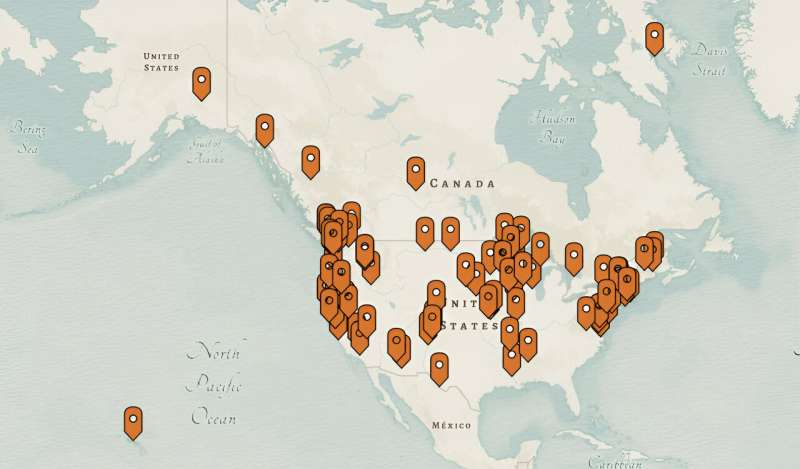This article has been reviewed according to Science X's editorial process and policies. Editors have highlighted the following attributes while ensuring the content's credibility:
fact-checked
trusted source
proofread
New site documents #landback movement, supporting return of land to Indigenous owners

Returning land to original Indigenous owners has long been a personal and family interest to Sarah Deer. As the #landback movement has gained momentum on social media in recent years, Deer and a fellow University of Kansas researcher have launched a website to document cases of land return to sovereign tribes, provide resources for those interested in doing so, and connect researchers, advocates, and others interested in land return.
A story maps site
powered by ArcGIS technology is now online and documents cases of landowners returning property to the original Indigenous owners across North America. With each arrow on a map, visitors can find links to news coverage of such transfers and links to the sites of the sovereign tribes who were returned their land. Deer, University Distinguished Professor of Women, Gender & Sexuality Studies, Indigenous Studies and by courtesy law at KU, first saw a
Deer later approached Ward Lyles, associate professor of public affairs and administration at KU, who researches land use, planning and related topics and had experience in mapping how land is used.
"That story got me interested in private land owners giving land back that was stolen. I didn't have a project in mind per se at first," Deer said. "I collected these stories, then got to know Ward. He's very interested in this movement and is very conscientious about land ownership and return and is a true ally. We decided to launch the project as a way to give credence to #landback, not just as a metaphor, but to also inspire landowners who came into stolen lands generations ago. We wanted to help show this is grassroots, on-the-ground framework."
The site is updated regularly, and as of October 2023 has documented more than 90 instances of private landowners, churches, municipalities and others returning land to Indigenous nations. Deer and Lyles said they have not collected every instance as people often do not want to publicize the return of land for various reasons. Locations are approximate as the researchers also wish to respect the people who decided to return land as well as tribes who have regained possession of their original territory.
The site also includes links to documents on how to legally return land, as the process is not as simple as a declaration in a will. Deer, who has written amicus briefs for the Supreme Court in cases involving Indigenous land rights and recently saw the high court rule in favor of her Muscogee (Creek) Nation in an Oklahoma land rights case, said she hopes to help anyone interested in land return.
"I want to make sure people know this is not something you can just do. You have to be intentional about it, to figure out the taxation issues, surveying and many other aspects of land transfer," Deer said. "We want to inspire potential returns and provide education about roadblocks to return. Scholars, activists and anyone interested in this topic is welcome to use it."
Lyles said he wanted to be part of the project as his scholarship deals with how land is used—often by cities, states and federal governments—and is interested in land and natural preservation. He is also an owner of land that was likely once Indigenous territory.
"Like most Americans, I am a settler-colonist without deep ancestral ties to this land. I say that even as someone able to trace my lineage in North America to before the Revolutionary War. Nowhere in my family's memorabilia is there an invitation from any Indigenous peoples saying, 'Please come take our land,'" Lyles said.
"Given the well-documented history of land theft—whether through violence, deception and swindling, legal manipulation, economic bullying or other means—we need to face the reality that most property 'owners' in the U.S. have control of property with an undeniably tainted title. One beauty of this project is that each of the individual stories of land return offers a message of hope and healing, in spite of the work of land return being contentious and complex."
Provided by University of Kansas





















